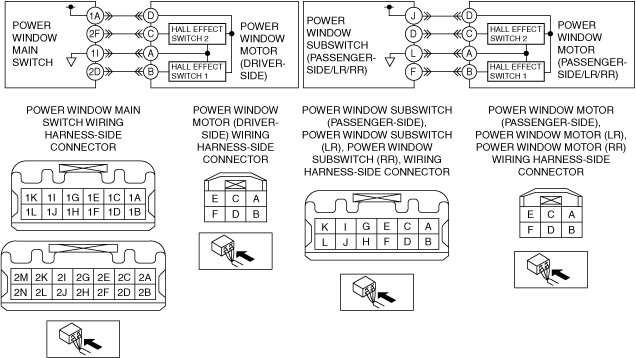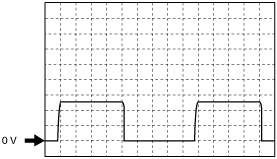|
1
|
INSPECT WHETHER POWER WINDOW SWITCH ENTERS FAIL-SAFE MODE OR NOT
• Switch the ignition to off for 3 minutes.
• Switch the ignition ON (engine off or on).
• Initialize the power window system.
• Operate the auto open/close function.
• Does the power window operate properly?
|
Yes
|
System is normal.
The power window system auto open/close function does not operate temporarily for any of the following reasons:
• The power window switch is operated while the power window motor protection circuit (integrated in power window motor) is operating.
• The power window main switch power supply is cut off by disconnection of the negative battery terminal or removing the fuse.
|
|
No
|
Go to the next step.
|
|
2
|
VERIFY WHETHER MALFUNCTION IS IN WIRING HARNESS (BETWEEN POWER WINDOW SWITCH AND POWER WINDOW MOTOR) OR ELSEWHERE
• Switch the ignition ON (engine off or on).
• Measure the pulse at the following power window switch terminals (sensor 1 signal):
-
? Driver-side (at power window main switch): 2D
? Except driver-side (at suspected door’s power window subswitch): F
• Is the pulse normal when the door glass is moving up and down?
|
Yes
|
Go to step 7.
|
|
No
|
Go to the next step.
|
|
3
|
VERIFY SENSOR 1 OUTPUT SIGNAL
• Switch the ignition ON (engine off or on).
• Measure the pulse at the following power window motor terminals B (sensor 1 signal):
• Is the pulse normal when the door glass is moving up and down in manual mode?
|
Yes
|
Go to the next step.
|
|
No
|
Replace the power window motor, then go to Step 12.
|
|
4
|
INSPECT WIRING HARNESS BETWEEN POWER WINDOW SWITCH AND POWER WINDOW MOTOR FOR CONTINUITY
• Switch the ignition to off.
• Disconnect the power window switch connector.
• Is there continuity between the following power window switch terminals (for driver’s door at power window main switch, for except driver’s door at suspected door’s power window subswitch) and power window motor terminals?
-
? Driver-side:
-
• 2D—B (sensor 1 signal)
• 1A—D (sensor power supply)
• 1I—A (ground signal)
-
? Except driver-side:
-
• F—B (sensor 1 signal)
• J—D (sensor power supply)
• L—A (ground signal)
|
Yes
|
Go to the next step.
|
|
No
|
Repair the wiring harness between the power window switch and power window motor, then go to Step 12.
|
|
5
|
VERIFY WHETHER MALFUNCTION IS IN WIRING HARNESS (BETWEEN POWER WINDOW SWITCH AND POWER WINDOW MOTOR) OR POWER WINDOW SWITCH
• Switch the ignition ON (engine off or on).
• Inspect the voltage at the following power window switch terminals (for driver’s door at power window main switch, for except driver’s door at suspected door’s power window subswitch):
-
? Driver-side
-
• 2D (sensor 1 signal)
• 1I (ground signal)
? Except driver-side
-
• F (sensor 1 signal)
• L (ground signal)
• Is the voltage B+?
|
Yes
|
Repair the wiring harness between the power window switch and power window motor, then go to Step 12.
|
|
No
|
Go to the next step.
|
|
6
|
VERIFY WHETHER MALFUNCTION IS IN WIRING HARNESS (BETWEEN POWER WINDOW SWITCH AND POWER WINDOW MOTOR) OR ELSEWHERE
• Is there continuity between the following power window switch terminals (wiring harness-side) (for driver’s door at power window main switch, for except driver’s door at suspected door’s power window subswitch) and ground?
-
? Driver-side
-
• 2D (sensor 1 signal)
• 1A (sensor power supply)
? Except driver-side
-
• F (sensor 1 signal)
• J (sensor power supply)
|
Yes
|
Replace the wiring harness between the power window switch and power window motor, then go to Step 12.
|
|
No
|
Replace the power window switch (open circuit or short to power supply in power window switch), then go to Step 12.
|
|
7
|
VERIFY WHETHER MALFUNCTION IS IN POWER WINDOW SWITCH OR ELSEWHERE
• Switch the ignition ON (engine off or on).
• Measure the pulse at the following power window switch terminals (sensor 2 signal) (for driver’s door at power window main switch, for except driver’s door at suspected door’s power window subswitch):
-
? Driver-side: 2F
? Except driver-side: D
• Is the pulse normal when the door glass is moving up and down?
|
Yes
|
Replace the power window switch (malfunction in power window switch automatic mode control), then go to Step 12.
|
|
No
|
Go to the next step.
|
|
8
|
VERIFY SENSOR 2 OUTPUT SIGNAL
• Switch the ignition ON (engine off or on).
• Measure the pulse at power window motor terminal C (sensor 2 signal).
• Is the pulse normal when door glass is moving up and down?
|
Yes
|
Go to the next step.
|
|
No
|
Replace the power window motor, then go to Step 12.
|
|
9
|
VERIFY WHETHER MALFUNCTION IS IN WIRING HARNESS (BETWEEN POWER WINDOW SWITCH AND POWER WINDOW MOTOR) OR ELSEWHERE
• Switch the ignition to off (LOCK).
• Disconnect the power window switch connector and power window motor connector.
• Is there continuity between the following power window switch terminals (for driver’s door at power window main switch, for except driver’s door at suspected door’s power window subswitch) and power window motor terminals?
-
? Driver-side: 2F and C (sensor 2 signal)
? Except driver-side: D and C (sensor 2 signal)
|
Yes
|
Go to the next step.
|
|
No
|
Repair the wiring harness between the power window switch and power window motor, then go to Step 12.
|
|
10
|
VERIFY WHETHER MALFUNCTION IS IN WIRING HARNESS (BETWEEN POWER WINDOW SWITCH AND POWER WINDOW MOTOR) OR ELSEWHERE
• Is there continuity between the following power window switch terminals (sensor 2 signal) (for driver’s door at power window main switch, for except driver’s door at suspected door’s power window subswitch) and ground?
-
? Driver-side: 2F
? Except driver-side: D
|
Yes
|
Repair the wiring harness between the power window switch and power window motor, then go to Step 12.
|
|
No
|
Go to the next step.
|
|
11
|
VERIFY WHETHER MALFUNCTION IS IN WIRING HARNESS (BETWEEN POWER WINDOW SWITCH AND POWER WINDOW MOTOR) OR POWER WINDOW SWITCH
• Switch the ignition ON (engine off or on).
• Measure the voltage at the following power window switch terminals (sensor 2 signal) (for driver’s door at power window main switch, for except driver’s door at suspected door’s power window subswitch):
-
? Driver-side: 2F
? Except driver-side: D
• Is the voltage B+?
|
Yes
|
Repair the wiring harness between the power window switch and front driver-side power window motor, then go to the next step.
|
|
No
|
Replace the power window switch (open circuit or short to power supply/ground in power window switch), then go to the next step.
|
|
12
|
REINSPECT MALFUNCTION SYMPTOM AFTER REPAIR
• Is malfunction no longer present?
|
Yes
|
• Troubleshooting completed.
• Explain repairs to the customer.
|
|
No
|
Reinspect malfunction symptoms, then repeat from Step 1 if malfunction recurs.
|

